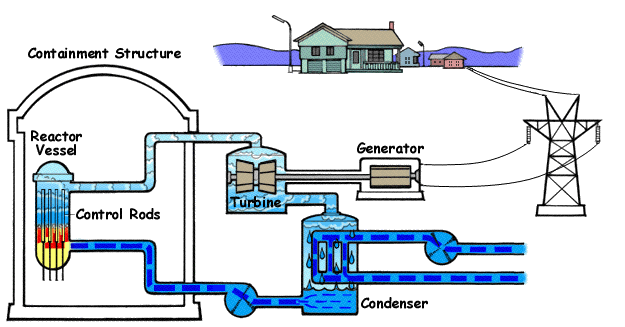The basic principle is simple: nuclear energy is used to produce
steam, the steam drives a turbine, and the turbine powers a generator, which
produces electricity.
Boiling water reactor
In a boiling water reactor, the nuclear reaction heats the water inside the reactor tank, causing it to boil. This creates the steam that drives the turbine. The turbine powers the generator, which in turn produces electricity.The steam is cooled in a condenser, and the resulting water sent back into the reactor and heated again.The Boiling Water Reactor (BWR)
(Source: http://www.nrc.gov/reading-rm/basic-ref/students/animated-bwr.html)

1. The reactor
Uranium atoms are split inside the reactor, producing heat. This causes the water to boil and turn to steam.
2. The turbine
Steam is released into the turbine, causing the blades to rotate at speeds up to 3,000 rpm.
3. The generator
The turbine powers a generator, which produces electricity.
4. The transformer
A transformer converts the electricity into a high-voltage current. This is then sent to the power grid via high-tension wires.
5. Sea water
To cool the steam back into water, a huge amount of sea water is pumped into the condenser via pipes about the same diameter as a finger. When this water is pumped back into the sea, it is about ten degrees warmer than it was before it entered the condenser. The sea water circulates through a closed system, and never comes in contact with the reactor water.
6. The condenser
In the condenser, the cold water running through the pipes cools the steam into water. This is pumped back into the reactor.









0 comments:
Post a Comment